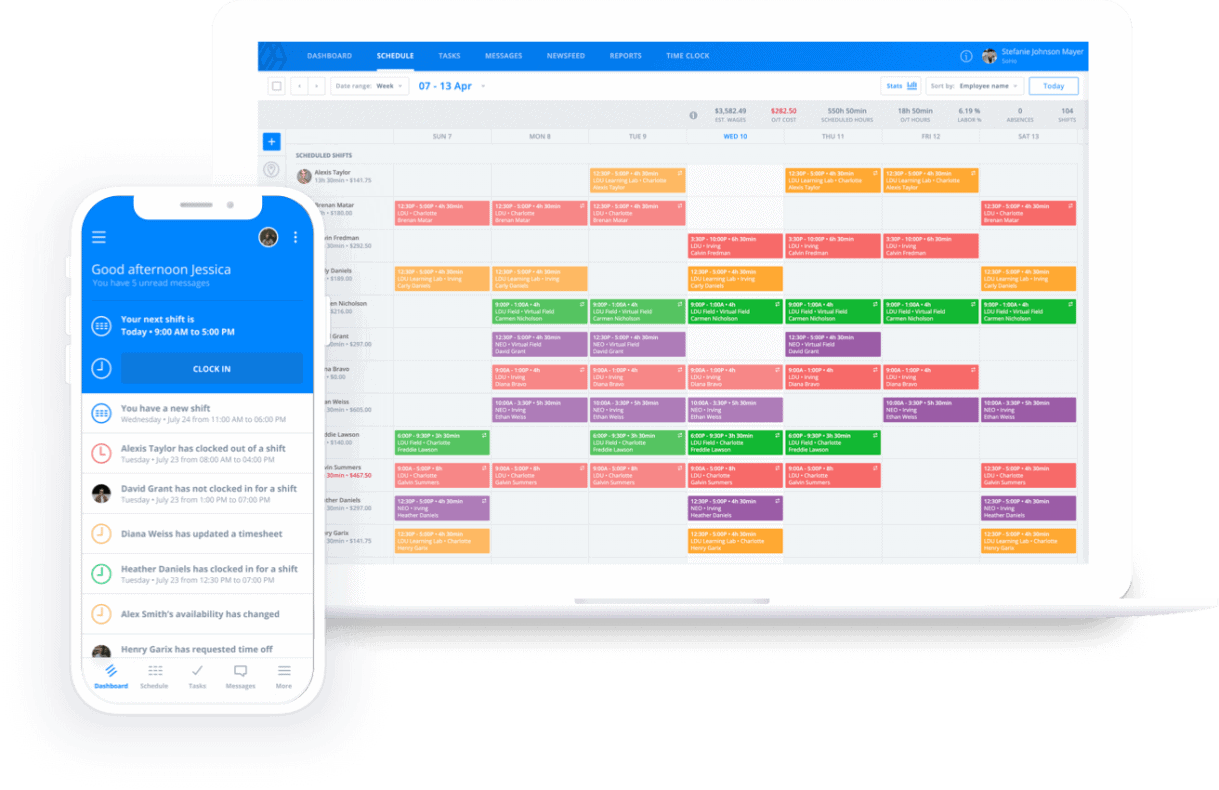11 Expert Tips For Improving Workplace Communication
Effective workplace communication is an essential element of your business’s s...

Motivation is defined as the general desire or willingness of someone to do something. Motivation in the workplace is no different. It’s your employee’s desire or willingness to produce great work. And when you think about it that way, it’s the holy grail that all managers strive for.
So how exactly do you motivate your team? In this article, the experts at Sling share 12 tips to help you keep your employees motivated, engaged, and productive.

It’s the old dilemma of the carrot or the stick. Which do you give your employees? Do you focus on the negative (the stick), or do you highlight the positive (the carrot)?
To improve motivation in the workplace, strive for positive reinforcement as much as possible. Yes, there may be a time when bad behaviors or results need to be pointed out, but for the most part, you can attract more flies with honey.
No one likes to do work for no reason. If they did, it wouldn’t be called work; it would be called play. But it would be monotonous play, and eventually, everyone would tire of it.
When you define the purpose of the work your team is doing, it helps them recognize the impact that it has on your clients and your company. This helps them feel like they’re making a difference and goes a long way toward keeping them motivated.
If you really want to improve motivation, don’t micromanage. Instead, give your team an assignment and a deadline, and then turn them loose. This gives your employees the freedom to work when their motivation is at its highest.
For some, early in the workday might be their most productive time. For others, it may be closer to the end of the day. For yet others, it may be overnight or on weekends.
When you allow your employees to decide when and how they will work, you establish a framework for improved efficiency and motivation.

Regardless of what business you are in, there are always small tasks that may seem insignificant. As a manager, you know that those small tasks play a large role in the productivity and success of your company. Unfortunately, your team members may not be aware of that fact.
You can increase motivation in the workplace by helping your employees focus on the big picture rather than the small job in front of them.
Show them exactly how that seemingly insignificant task can have a huge impact on the success or failure of the project or business as a whole.
To improve motivation in the workplace, be very clear about what you want done. A journey of a thousand miles starts with a single step.
So focus on that first step, be clear about what it is and how it can be completed, and then set your team to the task.
A clear and concise mission can light a fire of motivation under any team.

Remember the journey of a thousand miles? Each step along that road should be a measurable goal. That way, your team members can see what needs to be accomplished to get to the end.
Small, measurable goals are often easier to complete than one huge goal. When your team members make visible progress on a project, they’ll feel a boost of motivation that can carry them through the next step.
Small goals provide plenty of opportunities to recognize your team’s hard work and the results they produce. You don’t have to give anything tangible just yet (we’ll deal with that in the next section), but do supply specific reasons why they did a good job.
Try something like, “Great job on that article, James. It’s already increased traffic to our customer’s website tenfold over last month.”
When you show your appreciation and give particular reasons why the job they did was good, your employees will be motivated to do it again.
This method to improve motivation in the workplace is usually reserved for the end of a big project or the end of the year, but you can choose to do it any time. You can certainly reward excellent work with a bonus (i.e., money), but don’t limit yourself to that.
Get creative, think about what your team members need, and come up with a reward that fits each employee.
Your employees’ motivation depends, in large part, on their health. That may seem like common sense now, but you’d be surprised how many members of your team neglect to take care of themselves in the middle of a difficult project.
Encourage everyone to sleep eight hours whenever possible and to get regular exercise. When you promote the health of your team, you’re also promoting and improving their motivation.

In order to stay healthy—and in order to keep motivation high—your employee’s need to stay fueled. That means eating healthy and drinking plenty of water.
If you’re spending long hours in the office hammering out a big project, make sure everyone has healthy snacks. Pass out a bottle of water every hour or two. You can even order in lunch or dinner to keep energy levels, and motivation, as high as possible.
Regular breaks are a great time to relax and refuel. They’re also important for motivation.
Taking a break every hour gives your team member’s time to de-stress and unwind. Not only does this keep them physically healthy, but it also helps keep their creativity firing on all cylinders.
Think about this: how many times have you come up with a great idea while shooting the breeze in the breakroom? You may have to make regular breaks mandatory, but the performance and motivation of your team will benefit because of it.

Not every project is going to feel like a game of kickball on a warm spring day. That’s to be expected. Some projects are going to feel like getting your wisdom teeth out.
When those difficult projects rear their ugly heads, make it a point to find some way to have fun.
Of course, big things like ping pong or air hockey in the office do work, but there are other, smaller ways to make the workday fun and keep your team members engaged and motivated. Get creative.
In his 1943 paper entitled “A Theory Of Human Motivation,” Abraham Maslow suggested that safety (a.k.a. security) is one of two basic human needs.
In fact, a sense of security is so important for survival that it’s second only to the physiological needs (food, water, warmth, and rest) that all humans share.
While Maslow’s theory focuses on individual personal development, the concept transfers nicely to the realm of motivation in the workplace.
Once your team members feel secure to be themselves within your business, they’ll be motivated to build and improve their potential.
That’s good news for your business because when your employees strive to reach their full potential, your business benefits.
Another powerful way to improve motivation in the workplace is to build on the sense of security mentioned in the previous section by promoting inclusivity.
Workplace inclusivity includes the practices and attitudes of your business that ensure that everyone:
That may sound like a lot, but it boils down to the fact that all team member’s thoughts, ideas, and perspectives matter.
When you develop inclusivity by making everyone feel like a valuable member of the team, you lay the groundwork for their motivation to grow and improve as well.

At its most basic, teamwork is a feeling of unity that brings your team together and helps them overcome obstacles for the betterment of your business.
Without a strong sense of togetherness, individual team members may feel overwhelmed by the challenges they face day after day.
But as part of a team, those same individuals realize that the group is more powerful and more effective than the one. They’ll then be able to move forward, secure in the knowledge that their team members have their back.
For more information on how to build teamwork in your business, check out these articles from the Sling blog:
Your team has already proven that they can get the job done with the tools they have. But you can improve their motivation even more by upgrading their tools and their workspace.
This could be something as simple as switching to high-quality office supplies. Or it could be something as extravagant as purchasing a standing desk for everyone on your team.
Other upgrades include:
Get creative and we’re sure you can come up with plenty of ways to upgrade your employees’ tools and workspaces so they can stay motivated longer.
You can improve motivation and help your team get more done during the workday by encouraging efficiency in all their activities.
Even small changes that might not seem like much can result in significant improvements in motivation (not to mention inspiration, creativity, and productivity).
Take the time to examine your team’s habits and the processes they employ with an eye toward streamlining the way they work. You can even hire an efficiency expert to audit your business and offer suggestions.
Simple ways to encourage efficiency right now include:
For further discussion on these and other ways to encourage efficiency and improve motivation, take a few minutes to read these articles from the Sling blog:

Communication is one of the fundamental building blocks of both an effective team and an effective business. As such, motivation in the workplace depends a great deal on how well everyone communicates.
It’s important to keep in mind that communication is about more than just an exchange of information.
Effective, streamlined communication is also about how well the recipient understands what you’re trying to say. It doesn’t matter if you speak, draw, or write, if the message isn’t clear, your communication will suffer.
You can streamline your team’s communication by:
Making your team communication clearer, more concise, and more effective will dramatically improve not just employee motivation but also the way your business operates.
Cultivating a strong employee/employer relationship is a great way to improve motivation at work.
But the benefits of building bonds in your business extend well beyond motivation to include such things as:
If your business could benefit from any or all of these things, it’s worth the time to build successful relationships between you and your employees.
Here are some simple suggestions to get you started:
Want more information on building bonds with your employees? Take a few minutes to read this helpful article from the Sling blog: How To Have A Strong Employee/Employer Relationship.
When you make strong employee/employer relations a priority in your business, you open the door to improved motivation as well.
There’s no way to improve motivation in the workplace if your employees are burned out.
Employee burnout is mental, physical, and emotional exhaustion that leads to:
Rather than just the tension of a daily deadline, burnout is the ongoing, chronic stress that persists day after day and week after week.
The overwhelming feelings of burnout chip away at your team’s motivation, productivity, and engagement and result in exhaustion, general malaise, and even specific health symptoms.
Avoid employee burnout at all costs.
You can do this by taking the following actions in your business:
In addition, be on the lookout for such behaviors as:
These signs will help you identify employee burnout so you can take steps to get your team back on track.
There’s no time like the present to begin improving your team’s motivation. We suggest picking one or two methods from the list above and implementing them in your business. Once you’re comfortable with those, pick one or two more. Soon, you’ll be a master of motivation and your team will be performing at a higher level than ever before.

One of the best ways to improve motivation in the workplace is through scheduling.
Offering unique scheduling options gives your team more control over when, where, and how they work.
That makes it easy to start building motivation from the ground up and paves the way for your other efforts to gain traction.
Examples of these unique schedule options include:
Scheduling software like Sling simplifies the process of organizing and arranging even the most complicated shifts so that you can sit down, make your schedule, and move on to more pressing matters.
All of Sling’s cloud-based features — from schedule creation to time clock to payroll calculations — make it easy for you to create the best schedule possible, distribute it with ease, make changes, and juggle time-off requests.
Sling even provides suggestions and warnings when you’ve double-booked a team member or created a conflict in another part of your schedule.
All of this — and much more — makes Sling the tool of choice to help you retain high-potential employees.
For more free resources to help you manage your business better, organize and schedule your team, and track and calculate labor costs, visit GetSling.com today.
See Here For Last Updated Dates: Link
This content is for informational purposes and is not intended as legal, tax, HR, or any other professional advice. Please contact an attorney or other professional for specific advice.
Schedule faster, communicate better, get things done.